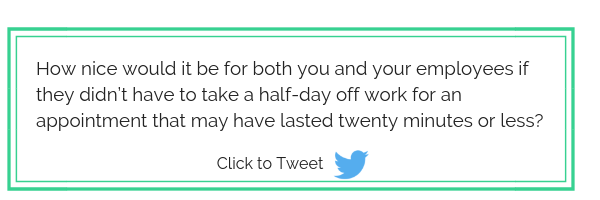Picture yourself fresh out of college and working in your first “real” job. You were offered a salary (you thought you were rich), you got your own desk (you thought you were cool), and you signed up for the benefits package (you thought you were so responsible). Now you’ve grown up and your needs and responsibilities have changed so you consider other career opportunities. You’re wiser now and you realize the salary offered isn’t the whole story. The benefits show a richer picture of what life would be like at a company. How does your company see their employees? How do they value them and the work they do? Do the benefits offered to employees match the mission of the organization?
Read straight from our founder about Health Benefits and the path of least resistance!
The same scenario plays out for companies too. It’s highly likely that what was needed in the beginning is different than what is needed now. Once companies start to see their values and mission through the lens of the benefits offered, employees become more than the worker bees. It’s apparent they are the lifeblood of the important work being done. When employees are valued and feel valued, everybody wins. Companies want to keep costs realistic, but remember how much more it costs to train new employees versus keeping good employees happy. And by now you know it’s not just about the money, in fact, it might not be the money at all. According to Glassdoor, job seekers’ top two swaying factors are salary and benefits and 79% of employees would prefer better benefits over a raise. At the top of the list of most desired employee benefits? Healthcare insurance.

Five tips for having your benefits package grow with your company:
- Solid employee benefits can be used as a recruiting tool.
If professionals are saying medical and dental coverage is most important to them and your company is offering these already, highlight that in your company profile. But beware, if your coverage isn’t very good, this can backfire. Just saying “benefits package available” isn’t enough and now might be the time to do better in this category. You’re paying for employee health care coverage anyway, shouldn’t it be good? Especially if you know that’s what’s most important to people? Investing in the welfare of employees with ‘health and wellness’ benefits can help attract and keep good employees.
- Ask your employees what they want from their health care benefits.
One of the most forward-thinking responses companies are doing to address health care coverage is investing in on-site health care clinics. According to National Association of
Worksite Health Center (NAWHC), there are many reasons why employers of all sizes should consider an onsite clinic, including to reduce lost productivity, reduce the use and cost of hospital emergency rooms for non-emergency conditions, lessening the severity of common illnesses, improve management of chronic conditions that require regular checkups, and increase healthy habits overall. NAWHC helps organizations of all sizes create onsite clinics through education, surveys, website resources, and research projects. How nice would it be for both you and your employees if they didn’t have to take a half-day off work for an appointment that may have lasted twenty minutes or less?
- Shop around
Just as you would try to find the most cost-effective options for anything else your company needs, you want to shop around for the best and most affordable employee benefits available. Are you paying too much for life insurance policies? Could you bundle what you're doing now with another service you need and get a reduced price? Needs change as companies change and what you needed early has probably changed with what you need currently. The good news is that improvements don’t always have to equal paying more money. You could find out that you are over-insured in certain areas and underinsured in others. Taking stock of what your employees need now and finding researching the options could open up new and more efficient ways of providing quality employee benefits.

- Remember employees on all levels
As your company expands, so do the groups of people working for you. Your first employees were drawn in by certain necessary benefits but what about those who are now with you in different capacities? They are no less important and necessary but because of their level of employment, they may be overlooked in your company’s benefits packages. Rethink this immediately and consider employee benefits that keep everyone in mind. On-site healthcare, wellness programs, commuter assistance, paid child-care leave, are benefits that are appreciated at all levels and increase productivity and satisfaction.
- Low-cost options
Not everything has to cost a lot to mean a lot. Glassdoor’s survey rated several employee benefits that were highly desired. While healthcare is the most coveted, it’s also the most expensive. Consider adding some of these options to your list of benefits: Paid sick days, flexible schedule (e.g., work from home), Office perks (e.g., free lunch, casual dress), employee development programs (e.g., on-the-job training, professional development), tuition reimbursement, and employee discounts.
Companies are offering remarkable perks to attract candidates and keep their best employees. As your company sees more success and grows each year, make sure the accomplishments are reflected in the way you treat the people who helped achieve that success.
.png?width=433&name=NeoPath_2019_logo_2color%20(1).png)





